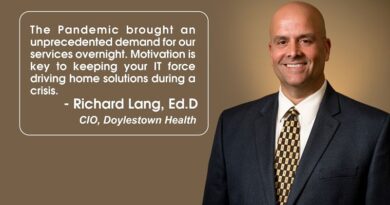How Healthcare Consumerism can ready the industry for the next ten years
By Muhammad Siddiqui, CIO, International Medical Center
One of the most frustrating aspects of the healthcare system for patients right now is how difficult it is to understand the various players. Communication and transactions are complex and time-consuming because of the dispersed nature of the ecosystem. Consumers’ expectations are high in the healthcare sector due to the highly personalized and convenient experiences they’ve had in other sectors.
If you buy anything online and travel, you want a frictionless experience. Platforms for e-commerce are making every effort to improve the user experience. Since everything is tailored to your preferences, you no longer have to drive to the mall to do some shopping. Your order can be delivered in less than an hour with just a few clicks. E-commerce platforms use AI and behavioral information to forecast your interests and customize your purchasing experience. Consumerism in health is a simple way of saying that patients are actively engaged in their very own health and wellness.
Traditional healthcare providers still face a barrier in making investments in back-end infrastructure that would allow for a digital experience.
“Healthcare consumerism,” as medical practitioners call it, refers to individuals making decisions about their own health care. ‘Patient-centered care,’ as the word suggests, places patients at the center of the healthcare decision-making process. As healthcare expenses continue to grow, patients are seeking a similar experience to what they enjoy in other service industries, like banking or retail.
Uber and Lyft, two firms at the vanguard of the transportation revolution, are no exception. Because the way it portrays the journey from point A to point B, Uber has mastered the art of consumer marketing. You don’t have to wait in lines or worry about payments because they’ve taken care of everything. Can healthcare businesses aspire to make this transition by making the process frictionless – from booking appointments as simple as making an Uber reservation?
According to a Definitive Healthcare survey, Health care consumerism was a top trend in 2018 and projected to continue to define the industry’s future and maintain its long-term viability.
Creating a consumer experience that is connected
If you’re concerned about managing your health and wellness from home, wearable technology has become a significant part of your daily routine. In contrast, barely half of the healthcare professionals inquire about wearable tech data during appointments, although 57% of consumers believe this data would be useful in their healthcare discussions.
Consider the case where you use your banking app to make a purchase and the transaction goes through. So, the next step is to contact customer service or go to the bank to view the information. As soon as you pick up the phone, you expect the person on the other end to know exactly what you’re trying to say.
When a physician advises in-house therapy or diagnostic testing following a digital consultation, the patient expects the hospital to have that information and not burden them with a new process. But this is not what happens in many care settings. Can we change that?
Patients’ dissatisfaction can be remedied with a well-designed CRM system. Adopting digital capabilities, such as digital apps, the usage of AI, and wearables, in order to remain competitive and future-ready.
Traditional healthcare providers still face a barrier in making investments in back-end infrastructure that would allow for a digital experience. Good digital tools are helping to increase patient autonomy, leading to an increase in patient care, greater retention and adherence. The healthcare business will benefit financially from this initiative. Reduced healthcare expenses are directly correlated to greater patient empowerment. Though most large healthcare providers have launched mobile applications, businesses will need to add new features, such as integrating data from wearable gear into the app.
Mergers and Acquisitions in Digital Health
Digital health deal volume grew by more than 26% in 2021. A sign that healthcare organizations are looking to adopt digital health companies that offer eHealth, telemedicine, and wearable technologies to get a head start on innovation.
Healthcare organizations can also partner with retail chains and e-commerce websites similar to other companies that are partnering with other industries to market their services. The cost of these services is minimal, but they will have a significant impact on the quality of patient experience Personalization, omnichannel customer experience, and improving the physical channel experience all play a role in this.
Booking appointments online should be as simple and convenient for our patients as shopping or purchasing groceries is for the rest of us – patients do not appreciate waiting to meet healthcare needs, just as they do not like to wait to book a hotel, airline, or shop.
How do we do this? Start simple, remove friction in the most painful areas of patient accessing care. Here at the International medical center hospital, the hospital advocates for person-centric solutions. IMC Patients can book in-person appointments and cancel or reschedule them without contacting any hospital department first. You can do this via IMC’s internet site, WhatsApp, chatbot, and mobile app since these systems are meant to give you time flexibility. You can also find out about hospital departments and treatment providers. The IMC application’s guardian feature allows you to register and manage appointments for your family members. Diagnostic testing can also be scheduled. In addition, patients can schedule E-visits from the comfort of their homes. Patients residing outside of the city’s core could use an E- visit to reach IMC’s treatment providers.
There is a lack of personalization in the healthcare industry, that means healthcare providers will have to catch up to the rest of society shortly. The company that is first to identify the customer, respond to their needs, and build long-term relationships will be ahead of the rest. In all elements of care delivery and engagement, a focus on wellness and prevention is essential. The patient is transformed into a customer with this level of customization.
Providers need to respond soon!



